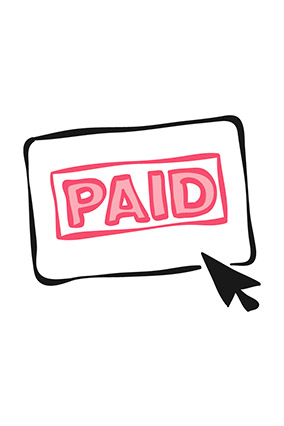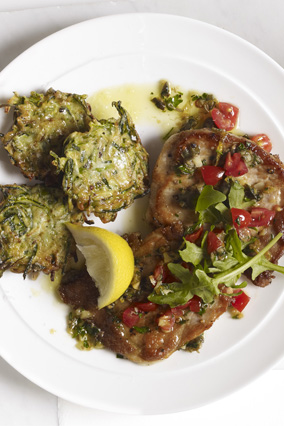By Amy Shearn | Oprah.com
Could it be that the reason you're in debt is less financial than it is emotional?

Illustration: Yale Center for British Art, Yale Art Gallery Collection
Lie #1: This is just how everyone lives now.
Where I live (as is the case, these days, with most of America), I am surrounded by people who can't quite afford their lives. A couple I know bought a place a few years ago when they were both working full time. They knew they could afford it (just barely...if they were really careful), but they also figured they were due for raises and bonuses.
I probably don't even need to report that they found they didn't love living on a shoestring, funneling everything into their mortgage, that neither one got the raise they expected, that as soon as they had a child, their situation became not just tenuous but also scary. This transition from spread-a-bit-thin to edge-of-poverty could happen to any of us: Many companies are forgoing automatic "cost-of-living" raises, while that pesky cost of living keeps rising. The inflation-adjusted median wage fell by 2 percent this year, reports CNN Money, which is to say, you're likely to make less money this year than you did last year, so instead of life getting less stressful, it's more so.
My friends ended up selling their place at a loss and renting, which felt like one giant step backward. But guess what? They are much happier renting a smaller place in a less-flashy neighborhood that they can comfortably afford.
My friends are now living the American dream. As Suze Orman explains in her book The Money Class, the goal should be "not merely to live within your means, but to live below your means. This is not meant to be a punitive strategy; it is a course in self-awareness, a return to values that our grandparents and their parents embraced. It is at the very core of the American dream of old."
Lie #2: Unexpected (aka not my fault) expenses come out of nowhere.
Hey, fellow 20th-century people, remember checkbooks? Remember balancing your checkbook? Something that involved pencils, math and knowing to the penny how much you had spent and had left to spend? Right, me too. In the world of online banking and paying for everything with plastic, it's easy to think you're on track, and then (surprise!) at the end of the month you realize that a couple of birthday presents and an emergency trip to the doctor/vet/mechanic have pushed you right over the edge—and somehow this happens every month.
So look alive and keep track of what your monthly "surprises" are to see if there is a pattern. For example, maybe you need to mentally devote more each month to anticipatable unanticipated healthcare costs. Suze Orman's Monthly Expense Calculator can help.
Lie #3: I'm the boss, so I need these boots. Also, a BMW.
"I love your outfit," a catty co-worker at my first real job told me. "It's so quirky-girl chic." I thanked her and headed immediately to the bathroom to blink at myself in the mirror, thinking, "What? But this is my super-duper-grown-up-lady-in-an-office outfit!" So I know that it's easy to feel outside pressure to present yourself in a certain way, to tell yourself, "I'm 40; I should have designer suits and a flawless manicure so my clients think I'm successful." While you may have a point—you can't wear jeans to argue in court—you also have now created an excuse to not only spend but also overspend. As in all matters of life, the trick is to worry less about what others around you seem to be doing and focus more on your life. Don't think in terms of what you ought to be able to afford, but in terms of what you actually can.
Lie #4: Oh, what's a few hundred more in the hole?
So you've got student loans, a mortgage, car payments—what's a little credit card debt on top of all that? Well, there's a big difference between good debt and bad debt. Good debt: money borrowed to purchase an asset that will build your wealth (like a home you can afford) or invests in the future (like getting an advanced degree). Bad debt: money borrowed to buy something that immediately begins to lose value, like a car or, sorry, a vacation. As Suze Orman puts it, bad debt finances "a want rather than a need."
Plus, not to be boring, but you're paying a lot more interest on credit card debt (up to 20 percent) than on, say, a 30-year mortgage (under 4 percent). Adding even a little bit of bad debt every month is going to create a snowball, an extremely harrowing snowball. So restrict your debt to the good kind and your snowballs to the snowy kind.
Lie #5: I know I'm supposed to give up $14-per-pound artisanal cheese, but I cannot live without a few tiny treats.
We've all heard the financial advice not to let seemingly small splurges add up. Let me admit that I hate this advice. It's so painful, and I'm sure I'm not the only one who feels like little treats are the only treats I'm likely to get. So let's add an addendum here, which is that this is not a treatise against treats. Rather, we should all consider trading those daily latte-esque indulgences for other treats that are actually free: Instead of the cheapie manicure, promise yourself a bubble bath after the kids are in bed; instead of ordering in Thai food again, convince someone else to cook you dinner. (Feel free to forward this to the relevant parties.)
If you're not convinced, why not add up the piddly indulgences you've been telling yourself you need all month. Now think about that number: How much of your credit card debt would it erase? How about if you put a month of "nothings" into a special "nothing" account? Think it might eventually become "something" instead?
Lie #6: If things get really bad, there's always Santa. Or phantom Aunt Tilda.
We all bob along through the ocean of life buoyed by subconscious lies we use to convince ourselves we aren't about to be swarmed by sharks and chomped to bits at any moment...wait, where was I? Oh right, subconscious lies. I recently had a conversation with someone who had made a financial mess of his 20s and who said, not really joking, "I'll probably just declare bankruptcy and start fresh." Um, not really, though, right? That's like saying, "I'll keep eating doughnuts for every meal and then get liposuction." Not a good plan. For one thing, bankruptcy will affect your credit score for years to come. This seems obvious to most of us, but there are those subtle, not-quite-believed but not-quite-dismissed ideas of financial salvation rumbling around your brain: Maybe yours is that your parents will be able to get you out of a jam, or a great-aunt you never knew about will leave you a voluminous inheritance. Another terrible plan I've heard (only half-joked about) is marrying someone rich.
This is your life, and you are the boss of your life. Which means behaving like the smartest, most supportive, fiscally responsible boss you know.
Read More Personal Finance Articles








































